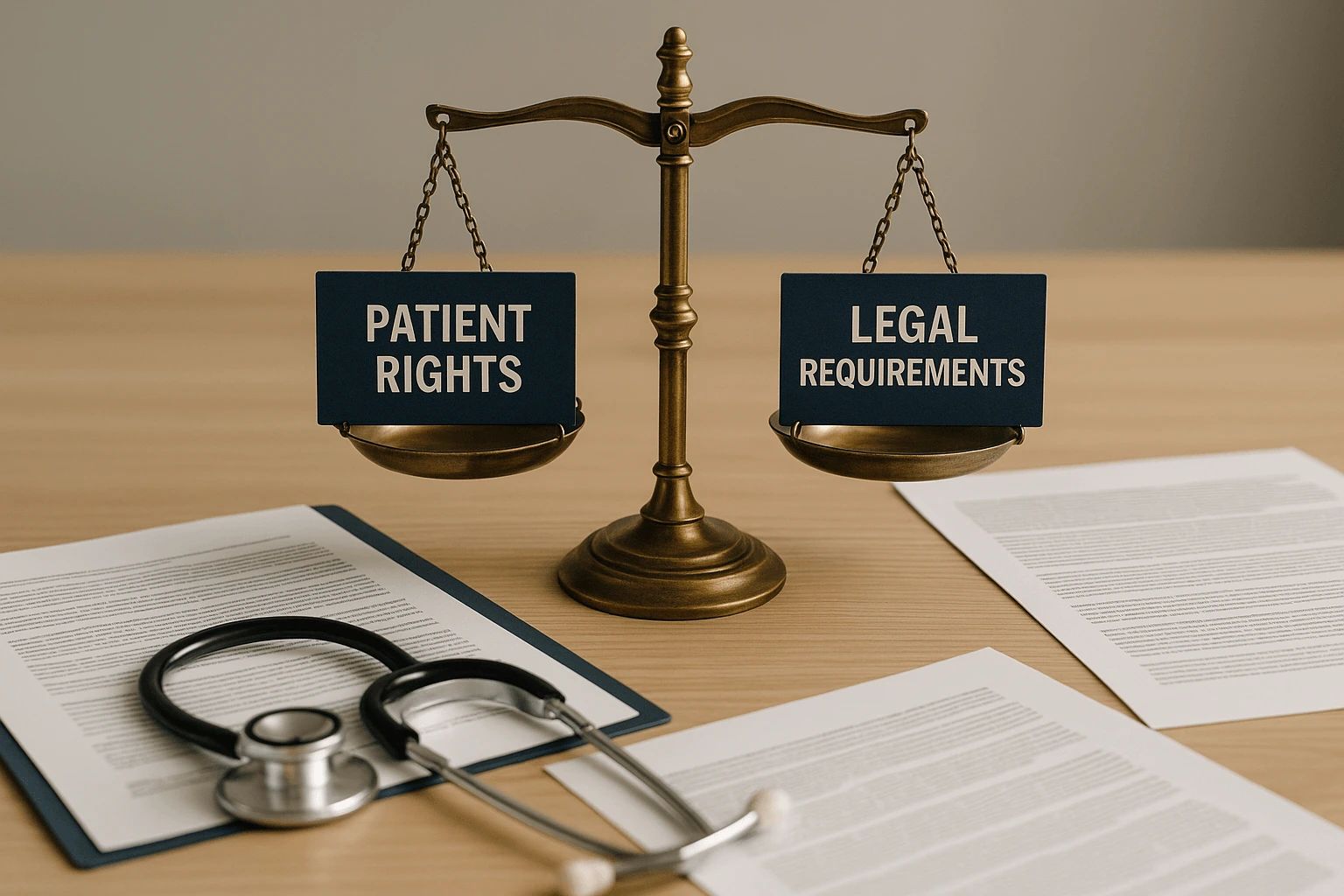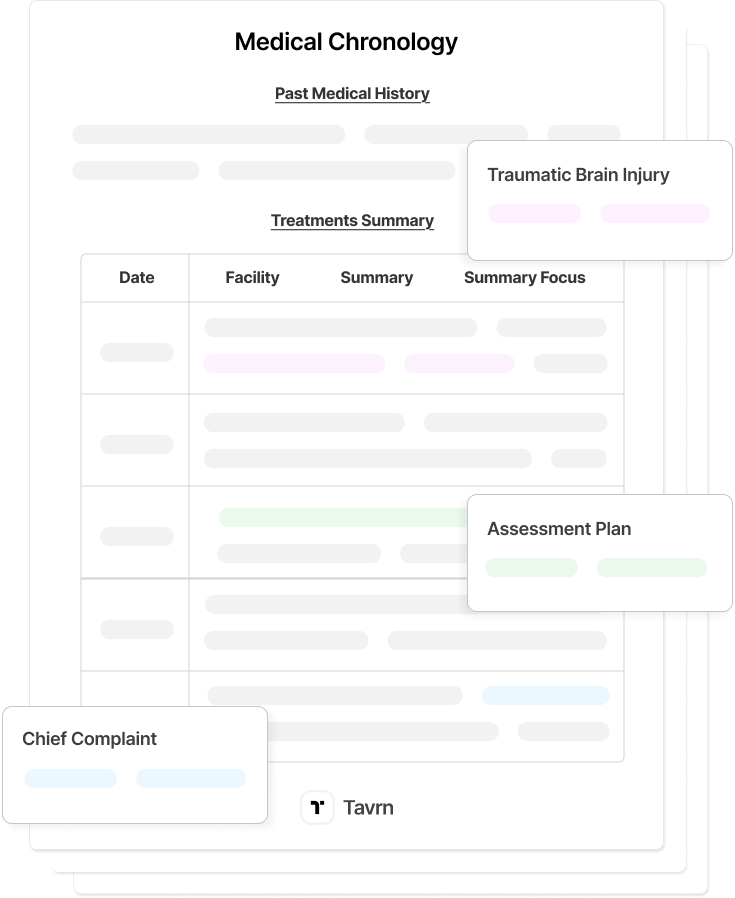Medical record retrieval delays can extend case timelines by hundreds of days, creating bottlenecks that stall settlements, frustrate clients, and erode firm profitability.
The root causes are systemic: provider infrastructure constraints, compliance complexity, fragmented workflows, and manual processes that can't scale with growing caseloads. Firms that treat retrieval as a strategic priority rather than a back-office task gain measurable advantages in case processing speed and settlement outcomes.
This article identifies the predictable bottlenecks in medical record retrieval, explains their financial impact on law firm operations, and outlines both process improvements and AI-powered solutions that reduce retrieval times by up to 70%.
What is the Medical Record Retrieval Process?
Medical records encompass all documentation created during patient care and serve as the evidentiary foundation of personal injury and medical malpractice cases. They capture every diagnostic, procedural, and treatment decision relevant to establishing liability and damages.
The retrieval process involves requesting complete documentation from healthcare providers through formal channels that comply with HIPAA and state regulations. Requests must include verified patient identification, proper authorization, and specific record parameters such as treatment dates and provider names.
Legal teams ensure successful medical record retrieval by promptly initiating requests, documenting details precisely, and consistently following up to meet statutory deadlines.
Why Timely Medical Records Matter
Medical records form the foundation for every substantive legal task: chronology development requires complete documentation, expert witness reviews depend on comprehensive medical histories, and demand letters need detailed factual support. Without records, even the most experienced legal teams cannot advance cases toward resolution.
Delays in record access create cascading operational problems that extend far beyond administrative inconvenience. Settlement negotiations lose momentum when opposing counsel questions incomplete documentation, expert witnesses can't provide meaningful opinions without detailed medical histories, and, finally, client confidence diminishes when case preparation appears stagnant despite their attorney's expertise.
Timely retrieval improves both legal outcomes and operational efficiency by enabling attorneys to focus on strategy rather than administrative delays. Firms that complete chronologies quickly can identify case strengths earlier, negotiate from stronger positions, and maintain client satisfaction through visible case progress.
What Slows Down Medical Record Retrieval?
Most retrieval delays follow predictable patterns.
1. Provider Bottlenecks
Healthcare providers face infrastructure constraints that create systematic delays, such as high volumes of electronic health records (EHRs) that compromise communication within and beyond EHR systems.
Medical facilities must balance record requests with ongoing patient care responsibilities, often using legacy systems not designed for high-volume external requests. Staff members typically handle record requests alongside primary clinical duties, creating competing priorities that affect response times.
Complexity increases when records span multiple providers or departments, particularly when facilities use different EHR systems that don't communicate seamlessly. Provider unresponsiveness typically stems from systemic overload rather than deliberate delay tactics or personnel inefficiency.
2. Privacy and Compliance Hurdles
HIPAA's 30-day requirement allows a single extension of an additional 30 days, creating a maximum 60-day total timeline for compliance. Special authorization requirements for mental health records and substance abuse documentation under 42 CFR Part 2 impose stricter confidentiality standards that require separate patient consent procedures.
These regulatory frameworks, while essential for patient privacy protection, introduce procedural steps that extend retrieval timelines. Authorization forms must meet specific legal standards, and any deficiencies—missing signatures, incorrect date ranges, or incomplete provider information—trigger rejection and resubmission cycles.
When cases involve treatment across multiple facilities or include protected categories of medical information, legal teams must navigate overlapping compliance requirements simultaneously. With each additional authorization step, the complexity and duration of medical retrieval increases.
3. Workflow Fragmentation
Workflow fragmentation is a key driver of documentation burden. Legal practices experience similar fragmentation when multiple staff members handle different aspects of record requests without centralized coordination.
Without unified tracking systems, firms rely on scattered spreadsheets, email threads, and manual status updates to monitor retrieval progress. Requests pass between intake coordinators, paralegals, and attorneys, with each handoff creating opportunities for miscommunication or lost follow-ups.
When staff members leave or shift responsibilities, institutional knowledge about provider contacts, pending requests, and escalation status often leaves with them. This decentralized approach makes it difficult to identify bottlenecks, prioritize urgent requests, or maintain consistent follow-up schedules across the firm's entire caseload.
4. Increasing Case Volume
Growing practices cannot scale retrieval workflows without structured systems and clear accountability. Manual processes that work adequately for a dozen active cases break down entirely when managing fifty or a hundred simultaneously. What once seemed manageable becomes impossible as volume exceeds human capacity to monitor effectively.
The consequences compound across the firm's operations.
- Priority cases get delayed because they're lost in the queue alongside routine requests.
- Follow-up deadlines pass unnoticed until clients inquire about case status.
- Paralegals spend increasing portions of their day simply trying to determine which requests are outstanding, which providers haven't responded, and which cases require immediate attention.
Without scalable systems, firms face a choice between limiting growth to match their administrative capacity or accepting that retrieval delays will undermine case quality and client satisfaction.
How Record Delays Hurt Law Firm Profitability
Understanding the causes of delayed medical records is just the first step. These delays also carry significant financial and operational consequences for law firms.
Direct Financial Impact:
- Extended case cycles stretch staff capacity and increase overhead costs.
- For contingency-fee practices, longer timelines delay revenue realization while expenses continue.
- Firms carry more active cases simultaneously without corresponding income.
Cash Flow Pressures:
- Cases remain active beyond anticipated resolution periods.
- Continued investment of time and resources without revenue creates operating gaps.
- Financial constraints affect hiring decisions and case selection criteria.
Operational Inefficiency:
- Paralegals spend time tracking records rather than advancing cases toward settlement.
- Misallocation of skilled labor reduces overall firm productivity.
- Limited capacity prevents firms from handling optimal caseloads.
Competitive Disadvantage:
- Inefficient retrieval processes raise per-case costs.
- Higher costs increase minimum damages thresholds for case profitability.
- Competitors with streamlined systems accept cases other firms must decline.
- Market position weakens over time as efficient competitors gain advantage.
Delayed medical record retrieval creates a chain reaction that affects every aspect of firm operations, from cash flow and staff productivity to case selection and competitive positioning. Addressing these delays with structured workflows and technology is essential for maintaining efficiency, maximizing revenue, and staying competitive in a demanding legal market.
How Law Firms Can Get Medical Records Faster
Law firms can implement immediate improvements to retrieval workflows without significant system changes or technology investments. These foundational steps create accountability and reduce predictable delays while preparing firms for eventual automation.
- Standardize HIPAA release forms and ensure all provider contact details are up to date and accurate to reduce correction cycles.
- Maintain updated provider communication databases to respect each facility's preferred contact methods.
- Define internal service-level agreements (SLAs) for request submission, follow-up protocols, and escalation.
- Assign single-point ownership for each retrieval request to prevent coordination gaps and missed follow-ups.
- Conduct weekly reviews of pending requests to identify consistently slow providers and develop alternative strategies.
- Document successful approaches for specific providers to preserve institutional knowledge.
- Establish escalation protocols for overdue requests, including notifying supervisors and conducting compliance checks.
- Build consistency and accountability as a foundation for future automation.
By implementing these structured workflow improvements, law firms can reduce delays, improve efficiency, and maintain consistent case momentum. These foundational practices deliver immediate results while positioning firms to maximize the impact of automation when they're ready to scale further.
How AI-Powered Retrieval Keeps Cases Moving
Modern retrieval platforms eliminate the operational bottlenecks that create predictable delays in medical record access. AI-powered systems handle the repetitive communication tasks that overwhelm paralegal capacity while maintaining professional standards and compliance requirements that legal practice demands.
Automated Outreach
AI-driven communication systems manage provider outreach with professional persistence that exceeds human capacity. These systems generate initial requests and send follow-up communications at optimal intervals.
Advanced AI systems provide end-to-end automated medical record retrieval workflows with centralized outreach capabilities, significantly reducing the need for manual tracking through integrated response dashboards.
AI agents maintain professional communication standards while handling multiple requests simultaneously, eliminating the capacity constraints that force firms to prioritize certain cases over others.
Intelligent Tracking and Escalation
Built-in tracking sequences automatically detect when providers exceed expected response timelines and trigger appropriate escalation protocols. Rule-based automation eliminates the idle time between initial requests and follow-up communications that characterizes manual workflows.
These systems monitor HIPAA compliance deadlines and alert legal teams when providers approach statutory limits. Automated escalation maintains consistent pressure on unresponsive providers while documenting compliance efforts for potential legal action if necessary.
Intelligent tracking gives paralegals the reliability and predictability they need to manage high-volume caseloads, receiving automated status updates and exception alerts that highlight cases requiring intervention.
Centralized Visibility
AI-powered platforms consolidate all retrieval requests into a single dashboard accessible to attorneys, paralegals, and operations leadership. Real-time status visibility eliminates the communication friction created by scattered email threads, spreadsheet tracking, and manual status reports.
The integration with major case management systems enables one-click record requests tied directly to specific clients' needs. This integration ensures that retrieved records are automatically associated with the correct case files without manual organization.
Compliance-Built Infrastructure
Automation strengthens legal compliance rather than creating additional risk exposure. Modern systems enforce HIPAA's 30-day requirement through automated deadline monitoring, generate compliant authorization forms, and maintain detailed audit logs for professional responsibility review.
Encrypted transmission protocols, secure storage systems, and role-based access controls protect confidential medical information throughout the retrieval process. These protections operate automatically as part of standard workflows rather than requiring additional compliance steps that slow operations.
Proven Turnaround Results
Firms using automation typically see average retrieval times reduced from weeks to days—up to 70% faster than manual processes. The Association of Legal Administrators reports that AI automation reduces processing time for voluminous patient files by 50% compared to traditional methods.
This time acceleration enables faster chronology development, earlier expert witness coordination, and more responsive client communication. Settlement documentation becomes available weeks or months earlier, creating a competitive advantage in negotiation timing and case positioning.
Retrieval as a Competitive Differentiator
Medical record retrieval is the foundation that determines whether cases advance efficiently or stall in delays that erode profitability and client satisfaction. The bottlenecks are predictable: provider infrastructure constraints, compliance complexity, workflow fragmentation, and scaling challenges. These problems compound across firm operations, affecting cash flow, staff productivity, case selection, and competitive positioning.
The firms that solve these retrieval challenges gain a measurable competitive advantage. They handle higher caseloads with existing staff, maintain healthier cash flow through faster settlements, and accept profitable cases that competitors must decline.
Tavrn handles provider outreach, compliance tracking, and document organization—eliminating the manual coordination that overwhelms paralegal capacity. With Tavrn, law firms report up to 70% faster retrieval times, enabling them to prepare cases more efficiently, maintain negotiation leverage, and deliver timely results to clients while competitors remain stuck in administrative delays.
Learn how to take control of your case timelines. Book a demo.






.webp)
.webp)




















































